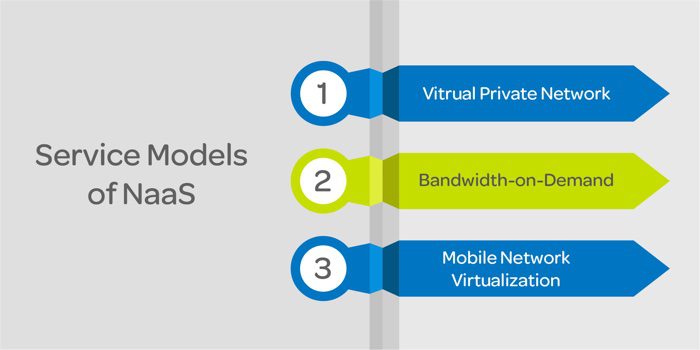In the era of cloud computing, many compute functions are being offered as an on-demand service with metered use. While on-demand software could rightfully be traced back to the mainframes of the 1960s, arguably it started in the modern era with Salesforce and SaaS in 1999 launching its CRM software-as-a-service.
Since then there have been numerous other as-a-service offerings, from virtualized operating environments, storage, application development, desktops and even disaster recovery.
Include network as a service (NaaS) in that collection. NaaS is the sale of network services from a third-party to companies that don’t want to build their own networking infrastructure. Like all of the other as-a-service offerings, network as a service offers its functionality on a subscription basis, through the cloud, and with metered use, so you only pay for what you use.
Foundation of Network as a Service
NaaS is a series of network and value-added services – plus computing and network resources – sold as a service by communications service providers, including IT hardware vendors, cloud service providers, and telcos.
NaaS is presented to the customer though a single self-service portal where the customer can order, deploy, and manage their services on demand as needed. This reduces the work needed and the level of expertise required to deploy services.
Like the other as-a-service offerings, it provides a networking setup through a subscription (an operating expense, or OPEX) rather than the large up-front acquisition cost (a capital expense, or CAPEX). That means while you start off much cheaper, you have to be wary of your use and to not let consumption costs exceed the Capex costs.
Networking as a service arose around 2015, as companies started to embrace software-defined networking (SDN). SDN decouples the network control and forwarding functions, enabling the network control to become directly programmable. This makes a SDN more adaptable, dynamic, manageable, and cost-effective than traditional networking because the SDN can adapt to networking changes on the fly as needed.
The abstraction of applications from the hardware layer enables the use of application programming interfaces (APIs) to orchestrate and manage the network infrastructure in a more flexible and extensible way. It was now possible to program your network.
As SDN grew, companies started to virtualize the network process and use virtual logic entities to control the network instead of utilizing hardware switches and nodes. Companies were able to reduce complexity and increase network automation, eliminated manual configuration, centralized control and monitoring and were able to deploy applications and services faster by leveraging open APIs.
Three Services of Network as a Service
As the name implies, networking is sold as a service. There are three primary services under the NaaS umbrella:
- Virtual private networks (VPN): NaaS extends a VPN and the resources contained in the network across other networks, like the public Internet. A VPN is only a point-to-point connection; from a remote worker’s laptop to the company network. But if they went outside the corporate network, they had no VPN protection. NaaS enables that protection outside the corporate firewall.
- Bandwidth on demand (BoD): A technique by which network capacity is assigned based on requirements between different nodes or users. An app or user who suddenly needs more bandwidth can be dynamically adjusted to their needs.
- Mobile network virtualization: This is a model where a telecommunications manufacturer or independent network operator – many of whom are NaaS providers — builds and operates a network and sells its communication access capabilities to third parties.
NaaS technology contains three distinct sub-categories, each of which is sold as a service.
Benefits of NaaS
SDN set the stage for NaaS because it broke the dependency on physical servers and networking hardware in traditional networking setups. With NaaS, a lot of the network administration can also be outsourced, giving a company flexibility and freedom to manage a network with less in-house technical expertise.
This means a company can offload day-to-day maintenance of equipment and network administration and focus on their line of business.
That’s just the beginning. NaaS can include services such as Wide Area Networking (WAN) connectivity, data center connectivity, cloud connectivity, bandwidth on demand, security services, and other applications.
Because your networking is provided by a service provider, you are protected with Service level agreements (SLAs) guarantee concerns such as levels of availability, network uptime, and response and resolution times for addressing issues. A good NaaS provider will optimize your network for your needs, so it’s important to establish performance expectations before signing the contract.
NaaS Pros and Cons
Like any as a Service offering, you need to watch your usage. Data is being moved around more than ever and datasets are growing exponentially in this era of Big Data and artificial intelligence. You can easily run up a bill that eats up any potential savings realized from migrating to NaaS.
Another challenge is tradeoffs associated with kinds of outsourcing like ceding too much control of your assets to the provider. Such issues have already come up as relates to storage and who owns the data. Setting expectations in the contract and SLA are key.
Legacy data centers may prove challenging to upgrade. If you are heavily-dependent on the pre-cloud MPLS technology and have deployed little of SD-WAN, for example, you may have trouble migrating. Older hardware, like switches and routers, or on-premises applications not written for the cloud, may also prove problematic.
Finally there is always the risk of vendor lock-in. As mentioned earlier, cloud service providers have different specialties and moving off one may prove difficult because other providers don’t offer the same services. And there is always the risk that an organization may become too reliant on a particular service provider and become stuck with them.
Best Practice of NaaS
As with any as-a-Service model, the best use is to make your firm more agile and responsive to any changes in your environment. Many companies with seasonal crushes, such as Christmas, rely on AWS, Azure, etc., for bursts of compute power when needed and then dial back their usage after the need has passed.
Rely on your NaaS provider to offer the network administration skills you might not have so you can focus on core business competency and not worry about network administration. Shifting off your enterprise network to NaaS enables enterprises to scale bandwidth much quicker for increased mobile use or for excess capacity when needed. This allows customers to use features and services they might not otherwise use because they might not have had the skill sets needed in-house.
Likewise, the provider can help address capacity limitations behind the scenes so all you have to concern yourself with is rolling out line-of-business services and not setting up the network.
Who Sells NaaS and Where Do You Buy It?
Assessments of the growth of NaaS vary by research firm. Market Insights Reports predicts the NaaS market will grow from USD $6.5 billion in 2020 to USD $23.6 billion by 2026, at a Compound Annual Growth Rate (CAGR) of 38.2% during the forecast period.
According to Market Research Future, the NaaS market is growing at a scorching 28 percent CAGR rate.
So who is selling NaaS? For starters, all of the major public cloud vendors – AWS, Azure, Google Cloud Platform, IBM Cloud, Rackspace, and so on. Major networking vendors like Cisco Systems, Juniper Networks, VMware, Aryaka Networks, and Brocade offer it, as do top communications firms like Alcatel Lucent, AT&T, Ciena, Akamai Technologies, Broadcom, Century Link, Inc., Citrix Systems, and Verizon.
NaaS providers vary in their offerings from one to the next, depending on the specialty of the provider. For example, Aryaka offers WAN and secure Virtual Private Networks (VPN) as a service, since it specializes in SD-WAN. Akamai offers CDN as a service because it is a content delivery network. With hundreds of services available, Amazon offers a massive variety of services.
Future of NaaS
NaaS is built on three emerging and growing technologies: SD-WAN, 5G, and Zero Trust networks.
To be clear, NaaS is the realization of SDN as the middle of the network for a cloud-centric enterprise architecture, or the “middle mile.” It brings SDN with its programmable networking to WAN services. But it only handles the middle mile. It does not address what is known as the “last mile,” and while some NaaS vendors may offer last mile connections between customers and POPs, not all do.
5G holds much promise but is still more vapor than product. As the expensive rollout continues, more services can be deployed around it. Of particular value is the network slicing of 5G, which virtualizes the network to insure an isolated end-to-end connection that delivers all of the needed services.
The same holds true to Zero Trust, the next step beyond the VPN in securing a network. Zero Trust networks are only now being rolled out and will grow over the next few years as a much more secure replacement to the VPN.
So as SD-WAN, 5G, and Zero Trust networks grow – and they will grow rapidly – so will Network as a Service.





